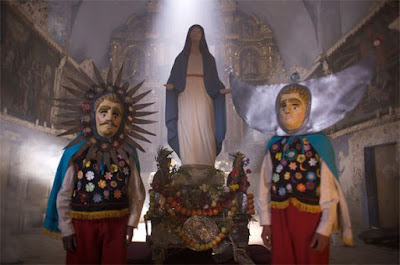Altiplano
Altiplano (2009) is a American-Belgian drama film directed by Peter Brosens and Jessica Woodworth. The movie recounts the realities of different people around the world (Europe, Middle East, and South America), but that redemption from their tragic lives at the small Quechua village called Turubamba of the Andean plateau. With dialogues in five languages (French, English, Persian and Quechua), Altiplano shows us a world divided, but that connects through feelings and travels with images.
The film begins with a devastating event that gives us to understand that the plot was based on the suspense and mixed feelings that arise from equally bittersweet moments. Grace (Jasmin Tabatabai) is a photographer who travels to Iraq where her guide and friend is murdered in front of her eyes and she is forced to photograph the scene. Despite the advice of his family to publish the photograph so that the world knows the story, the trauma caused by that death eats away at his conscience and leaves him in a state of desolation. Her partner travels to Turubamba on a medical mission but she remains in Belgium, unable to continue with the art of capturing painful realities in photographs.
Parallel to the situation of Grace, the young indigenous Saturnina (Magaly Solier) introduces us to know the small town called Turubamba (the location is fictional for this movie, but the name belongs to a village in Ecuador) and their own tragedies. Saturnina plans to get married, but a mercury spill from the gold mines around the area has left most of Turubamba's people blind or close to death which compromises Saturina's plans. Her story and the struggles of the Turubamba village are presented as the main plot of the movie. In a somewhat surreal and lyrical way, Brosens and Woodworth show us a Latin America in which the indigenous traditions and beliefs are blended with Catholicism creating a unique culture. For example, Saturnina is the guard of the figure of the Virgin Mary and like her, all the people from the village attend to church and worship the saints. But simultaneously to the traditions acquired during the colonial period, they continue adoring the Sun, the Moon, Mother Nature, having rituals with corn, and speaking their own language, Quechua.
Saturnina's fiancee dies due to mercury poisoning. This event is a breakdown not only for Saturnina but for everyone concerned with Turubamba such as the mining companies and the doctors of the mission. The problem of the mining spills becomes sounder and people start protesting. Max (Oliver Gourmet), Grace's husband who was trying to investigate the causes of the poisoning with the rest of the medical crew dies accidentally during one of those protests. Overwhelmed with both casualties (her friend in Iraq and her partner in Turubamba), Grace travels to understand the situation in which Max died which was not recorded or reported anywhere. She finds Max's camera which contained a video of Saturnina's suicide. In the video, Saturnina leaves messages explaining her decision and the situation of her village. "Without images, there is no history" and "the mother Earth will never forgive our deed" are some of the shocking phrases that will remain in Grace's mind to help her find redemption.
Towards the end of the movie, the scenes are presented in black and white accompanied with sad music and shots of the faces of the indigenous killed by the contamination and their grieving families as a way to emphasize their feelings. The change in colour makes those moments more dramatic than the rest of the movie. The story does not go on relating the result of the protests for the mining or missions around, indeed, by the end of the movie those factors disappear completely leaving us only the images that reflect the feelings, the tragedy, and the fantasy of indigenous beliefs. Again like in other movies depicting Latin America, ecological problems and the struggles faced by minority groups seem to be the least important matter in the film. They are part of the movie just to propose plots that appeal to the audience for its realism.
Like in Gibson's "Apocalypto", Elliot's "The Debt", or even in the Zorro movies, the Latin American "real" drama is called to the screen with elements such as the language (Spanish or a native tongue), exploitation or the memories of it (resentments from colonization), and the combination of these with actual history of the region or of its people, especially of indigenous people.



